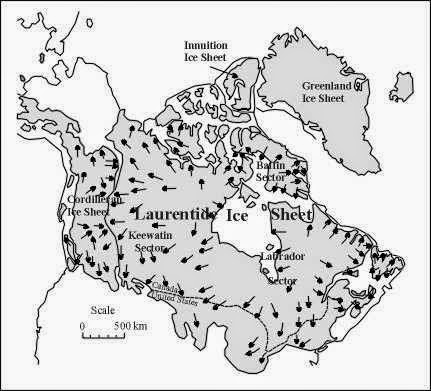Mt. Katahdin had stood tall for millions of years, slowly being revealed by eons of glaciers crawling over its crust, exposing the grandiose granite monolith to the world. Erratics are strewn across the landscape, along with thousands of kettle lakes, ponds and streams. Everything you lay your eyes on here was either formed by, or heavily influenced by glacial advancement, stagnation, or withdraw. The cirques and col, the striations on the boulders, the craggy exposed granite aréte known as the knifes edge, all are by-prouducts of the mighty Laurentide Ice Sheet that engulfed the continent 90,000-20,000 years ago. As it slowly withdrew, it left massive moraines in its wake, ever heard of Long Island, or Cape Cod? Finally on its way out of the United States, its massive weight and motion peeled away the outer layer of the Mt. Katahdin landscape, leaving what essentially what we see today.
Shown here is a wide angel view of the 5 peaks of Mt. Katahdin, in the foreground is one of the thousands of ponds formed by the glacial withdraw during the last ice age.
http://www.bio.umass.edu/biology/conn.river/iceages.html
Mt. Katahdin 10,000 years from today
I believe that Mt. Katahdin and the surrounding landscape will be mostly unchanged in the next 10,000 years, as on the geographic scale, 10,000 years is nearly unnoticeable. It is likely though that many more tonnes of granite will freeze-thaw and leave even more deposits of jagged granite stones on the peaks of Katahdin. In addition to this, I also believe that 10,000 more years of off-shore winds blowing on the mountain will cause a slight deformation in the area that receives the most wind, as some of the dust, gris, and other small debris will be blown away.
Mt. Katahdin 1,000,000 years from today
Mt. Katahdin 1 million years from now would be an even more impressive sight than it is today, as the next ice age we have may take place about 250,000-400,000 years from now and will have peeled away even more of Katahdins surrounding lowlands. The immense pressure generated by the glaciers mass will rearrange even more till and erratics throughout the area. Mt. Katahdin itself may even look cleaner, fresher, as the millions of tonnes of small rocks and debris that litter its peaks will be washed away to lower elevations by the glaciers motion.
Mt. Katahdin 100,000,000 years from today
Welcome to my chosen landscape, 100 million years from today, its not a pretty picture, the planet has destabilized drastically, no life has lived here for nearly 1.5 million years now. A massive solar flare blasted over Earth and literally stripped away the entire atmosphere, and since then, the planet has gone haywire. A super volcano located on a "hotspot" deep in the North American tectonic plate erupted 4,200 years ago and hasn't stopped releasing its magma load upon the planet.With the planets core releasing so much pressure through such a small opening, its has slowly started to degrade the outer crust over the entire area. This will lead to unimaginable destruction on a cosmic scale, when the pressure finally becomes too much for the globe to contain, the outer crust will shatter like glass, and the entire planet will explode instantaneously, launching matter into the dark vacuum of space, possibly seeding another planet in our essence and provide the chance for life to start again.
P.S. I love rocks ;)
















